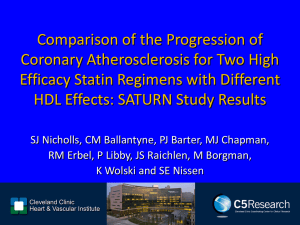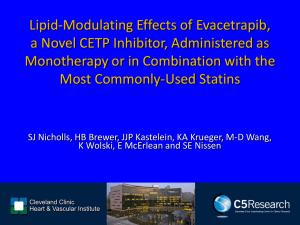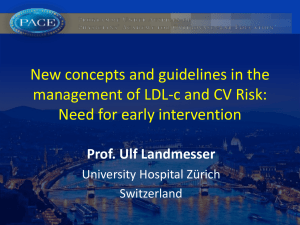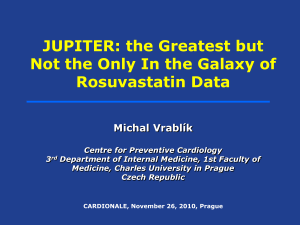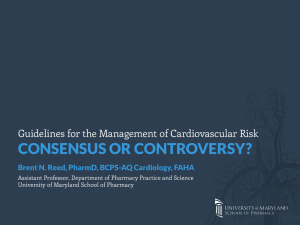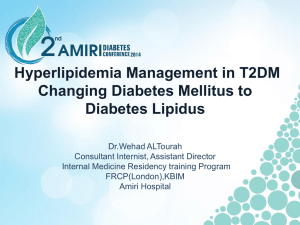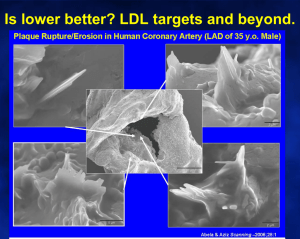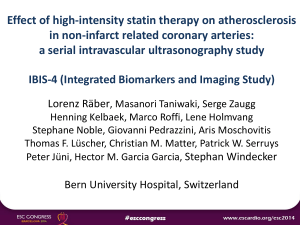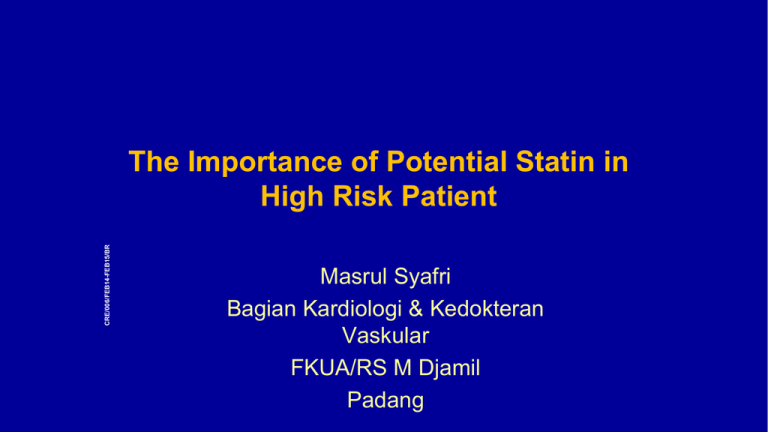
CRE/006/FEB14-FEB15/BR
The Importance of Potential Statin in
High Risk Patient
Masrul Syafri
Bagian Kardiologi & Kedokteran
Vaskular
FKUA/RS M Djamil
Padang
CVD is a leading cause of death
worldwide
According to the WHO,1
“An estimated 17.3 million people died from CVDs in 2008.”
“By 2030, almost 23.6 million people will die from CVDs.”
CHD remains the main cause of global mortality and a major
cause of morbidity and loss of quality of life.2
CVD: Cardiovascular disease
1. http://www.who.int/cardiovascular_diseases/en/
2. De Backer GG. Medicographia. 2009;31:343348.
New Paradigm: Multi-Risk Factor Approach
Multiple independent
risk factors (silo
approach)
CVD: Cardiovascular disease;
DM: Diabetes mellitus; HTN: Hypertension
Volpe M, et al. J Human Hypertens. 2008;22:154–157.
New CVD risk
perspective
DM
Diabetes
Hypercholesterolemia
HTN
Traditional CVD
perspective
New targets and
goals for therapy
Gender
Age
HTN
Hypercholesterolemia
Organ
damage
Smoking
Integrated identification and management of
risk factors contributing to CVD risk
(global approach)
Reduction of
total CVD risk
is the primary
goal
On-Treatment LDL-C is Closely Related to
CHD Events in Statin Trials – Lower is Better
30
4S - Placebo
25
Rx - Statin therapy
PRA – pravastatin
ATV - atorvastatin
Secondary Prevention
4S - Rx
20
15
10
LIPID - Placebo
CARE - Placebo
LIPID - Rx
CORONA - Placebo
CARE - Rx
CORONA - Rx
Primary Prevention
HPS
- Placebo
TNT – ATV10
HPS - Rx
PROVE-IT - PRA
WOSCOPS – Placebo
TNT – ATV80
AFCAPS - Placebo
PROVE-IT – ATV
5
6
AFCAPS - Rx
WOSCOPS - Rx
ASCOT - Placebo
ASCOT - Rx
0
40
(1.0)
60
(1.6)
80
100
120
140
(2.1)
(2.6)
(3.1)
(3.6)
LDL-C achieved mg/dL (mmol/L)
Adapted from Rosensen RS. Exp Opin Emerg Drugs 2004; 9(2): 269-279
LaRosa JC et al. N Engl J Med 2005; 352: 1425-1435
160
(4.1)
180
(4.7)
200
(5.2)
On-Treatment LDL-C is Closely Related to Stroke Events
in Statin Trials – Lower is Better
Relationship between protection from stroke events and LDL-C reduction
1.2
GISSI
1.0
ALLHAT-LLT
PROSPER
WOSCOPS
LIPID AFCAPS/TexCAPS
HPS ASCOT-LLA
4S
CARE
0.8
0.6
GREACE
0.4
MIRACL
0.2
-10
-20
-30
Reduction in LDL-C (%)
Amarenco P, et al. Stroke 2004;35:2902-2909
-40
-50
Relationship Between Proportional Reduction in
Events and Mean LDL-C Reduction at 1 Year
A prospective meta-analysis of data from 90,056 individuals from 14 statin trials
A 1 mmol/L (39 mg/dL) reduction in LDL-C was associated with a …..
50
…. 23% reduction in
major coronary events
50
40
Proportional reduction in
event rate (%SE)
Proportional reduction in
event rate (%SE)
40
30
20
10
0
-10
…. 21% reduction in
major vascular events
30
20
10
0
0.5
(19)
1.0
(38)
1.5
(58)
Reduction in
LDL-C mmol/L (mg/dL)
CTT Collaborators. Lancet 2005;366:1267–1278.
2.0
(77)
-10
0.5
(19)
1.0
(38)
1.5
(58)
Reduction in
LDL-C mmol/L (mg/dL)
2.0
(77)
History of U.S. Dyslipidemia Guideline
Development
1988
1993
2001
ATP I1
ATP II2
ATP III3
• Exclusive
focus on
LDL-C
• Risk
assessment
guides
therapy
• Lower LDLC threshold
for therapy
initiation in
high risk
patients
2004
2013
ATP III
Update4
• Lower LDLC threshold
for therapy
initiation in
very high
risk patients
ACC/AHA
Guidelines5
• Use of
moderateor highintensity
statin
therapy for
patients
across 4
major
groups at
risk for
ASCVD*
*ASCVD, Atherosclerotic Cardiovascular Disease
1. NCEP. Arch Intern Med .1988;148:36-69. 2. NCEP ATP II. Circulation .1994;89:1333-445. 3. NCEP ATP III. Circulation.
2002;106:3143.
4. Grundy SM, et al. Circulation. 2004;110:227-239.. 5. Stone NJ, et al. J Am Coll Cardiol. 2013: doi:10.1016/j.jacc.2013.11.002.
Available at: http://content.onlinejacc.org/article.aspx?articleid=1770217. Accessed November 13, 2013.
Target of LDL-C: NCEP-ATP III
Risk Category
LDL-C
0-1
< 160 mg/dl
2 (10-year risk <10%)
< 130 mg/dl
2 (10-year risk 10-20%)
< 130 mg/dl
(Optional goal: < 100 mg/dl)
CHD and CHD risk equivalent
Grundy SM, et al. NCEP Report. Circulation 2004;110:227-239
< 100 mg/dl
(optional goal: 70 mg/dl)
Recommendation for treatment target LDL-C
(ESC/EAS 2011)
Recommendation
Class
Level
VERY HIGH CV risk
(established CVD, DM type
1 &2 with target organ
damage, severe CKD or
SCORE level > 10%) the
LDL-C goal is < 70 mg/dl
and or > 50% reduction
when target level cannot be
reached
I
A
HIGH CV risk (markedly
elevated single risk
factor, a SCORE level >
5 to < 10%), an LDL-C
goal < 100 mg/dl
II a
A
MODERATE risk
(SCORE level >1 to< 5),
an LDL-C goal < 115
mg/dl
II a
C
2013 ACC/AHA Guideline Recommendations for
Statin Therapy
ASCVD Statin Benefit Groups
Heart healthy lifestyle habits are the foundation of ASCVD prevention
Clinical ASCVD
• High-Intensity
statin (age ≤75
years)
• Moderate-intensity
statin if >75 years
or not a candidate
for high-intensity
statin
Diabetes;
age 40-75 years*
Estimated 10-yr
ASCVD risk
≥7.5%†; age 40-75
years*
• High-intensity
statin
• Moderate-intensity
statin
• Moderate- to highintensity statin
• Moderate-intensity
statin if not a
candidate for highintensity statin
• High-intensity statin
if estimated 10 year
ASCVD risk ≥7.5%
LDL-C ≥190
mg/dL
ASCVD prevention benefit of statin therapy may be less clear in other groups . Consider additional factors
influencing ASCVD risk , potential ASCVD risk benefits and adverse effects, drug-drug interactions, and patient
preferences for statin treatment.
* With LDL-C of 70-189 mg/dL
† Estimated using the Pooled Cohort Risk Assessment Equations
Stone NJ, et al. J Am Coll Cardiol. 2013: doi:10.1016/j.jacc.2013.11.002. Available at:
http://content.onlinejacc.org/article.aspx?articleid=1770217. Accessed November 13, 2013.
Intensity of Statin Therapy
High-Intensity Statin
Therapy
LDL–C ↓ ≥50%
Atorvastatin (40†)–80 mg
Rosuvastatin 20 (40) mg
Moderate-Intensity
Stain Therapy
LDL–C ↓ 30% to <50%
Atorvastatin 10 (20) mg
Rosuvastatin (5) 10 mg
Simvastatin 20–40 mg‡
Pravastatin 40 (80) mg
Lovastatin 40 mg
Fluvastatin XL 80 mg
Fluvastatin 40 mg bid
Pitavastatin 2–4 mg
Low-Intensity Statin
Therapy
LDL–C ↓ <30%
Simvastatin 10 mg
Pravastatin 10–20 mg
Lovastatin 20 mg
Fluvastatin 20–40 mg
Pitavastatin 1 mg
Lifestyle modification remains a critical component of ASCVD risk reduction, both prior to and in concert with the use
of cholesterol lowering drug therapies.
Statins/doses that were not tested in randomized controlled trials (RCTs) reviewed are listed in italics
†Evidence from 1 RCT only: down-titration if unable to tolerate atorvastatin 80 mg in IDEAL
‡Initiation of or titration to simvastatin 80 mg not recommended by the FDA due to the increased risk of myopathy, including
rhabdomyolysis.
Stone NJ, et al. J Am Coll Cardiol. 2013: doi:10.1016/j.jacc.2013.11.002. Available at:
http://content.onlinejacc.org/article.aspx?articleid=1770217. Accessed November 13, 2013.
LDL Cholesterol
is
The Primary Target
in Dyslipedmia Treatment
NCEP ATP III 2003/ NCEP ATP III Update 2004
ADA/ACC Guideline Update for Secondary Prevention 2006
ESC/EAS Guidelines for the management of Dyslipidemias 2011
2013 ACC/AHA Guideline on the Treatment of Blood Cholesterol to Reduce
Atherosclerotic Cardiovascular Risk in Adults
Common dislipidemia patient in
Primary practice
In Germany dyslipidemia was highly frequent in
primary care (76% overall)1.
Life style intervention only control 10% dyslipidemia
of the patients1
After using pharmacotherapy, still many patient do
not achieve LDL-C1, same thing happens in Asia2,3
Starting doses is important, because commonly used
in clinical practice, and most of clinicians often fail to
titrate doses after initiating therapy to reach LDL
cholesterol goals1
1. Steinhagen-Thiessen, Cardiovascular Diabetology 2008, 7:31 doi:10.1186/1475-2840-7-31
2. Park et al, European Journal of Cardiovascular Prevention & Rehabilitation published online 7 March 2011 DOI:10.1177/1741826710397100
3. Pearson TA, et al The Lipid Treatment Assessment Project (L-TAP) Arch Intern Med 2000;160:459–467.
Management of Hypercholesterolaemia remains
Sub-optimal: Pan-Asian CEPHEUS
Survey conducted in eight Asian countries of 7281 patients on lipidlowering therapy for ≥3 months
Only 34.9% of very high risk patients reached NCEP ATP III
goal and it was below from overall result
Patients (%) at
LDL-C goal
65.1% of very high risk patients did not reach NCEP ATP III
goal
100
80
60
75.4
76
Moderate
<130 mg/dL
Lower
<160 mg/dL
55.4
49.1
34.9
40
20
0
Overall
Very-high
<70 mg/dL
High
<100 mg/dL)
Risk category and NCEP ATP III goal
Park JE et al. Eur J Cardiovasc Prevent Rehabil 2011; epub ahead of print.
Percentage of Patients at LDL-C goals recommended by the 2004 updated
NCEP ATP III* guidelines
% of Patients at LDL-C goals recommended by 2004 updated NCEP ATP III* guidelines
• For patients in Hong Kong the treatment goal attainment rate was 82.9% while patients in other
countries had very low LDL-C attainment rate (31.3 – 52.7%).
Park JE et al. Eur J Cardiovasc Prevent Rehabil 2011; epub ahead of print.
PAN-ASIAN CEPHEUS Study:
Follow-up of Patients not achieving LDL-C goals
Follow-up of patients not achieving LDL-C goals
Other follow-up treatment (n=40)
1.7
Lifestyle modification (n=332)
13.7
Dose increased+additional medication
(n=156)
6.4
Switched to another therapy (n=407)
16.8
Dose increased (n=618)
25.5
Same medication (n=871)
35.9
0
Park JE, et al. Eur J Prev Cardiol. 2012;19(4):781-794..
5
10
15
20
25
No. of patients (%)
30
35
40
Treatment Gap
31.3% of patients had attained their therapeutic
LDL-C goals.
This result was below that of the overall Asian
rate (49.1%)
Patients compliance with drug treatment
appeared to be very poor in the Indonesian
population.
Examples of higher risk patients who
may benefit from intensive treatment
TIA/stroke patients
Type 2 diabetes
Intensive treatment is
needed1
Atherosclerosis
• Target LDL-C <100mg/dL and
optionally <70mg/dL
Acute coronary
syndromes
Hyperlipidaemic
VTE patients
Women with CVD
Patients need
>50% LDL-C
reduction and
optimize HDL-C
Third report of the NCEP expert panel on detection, evaluation and treatment of high blood cholesterol on adults (ATP III). May 2001
Rosuvastatin in Acute Coronary Syndrome
Acute coronary syndromes
Acute Coronary Syndrome
No ST Elevation
ST Elevation
Non ST Elevation MI
Unstable Angina
Braunwald E et al. J Am Coll Cardiol 2000;36:970–1062.
Myocardial Infarction
Non Qw MI
Qw MI
Outcomes in primary prevention, stable and unstable
coronary disease
16
Death/nonfatal MI (%)
12
Unstable angina/non-Q-wave MI (FRISC
II)
Stable angina (SAPAT)
8
Primary prevention (WOSCOPS)
4
0
0
2
Wallentin L et al. Lancet 2000;356:9–16.
Juul-Moller S et al. Lancet 1992;340:1421–1425.
Shepherd J et al. N Engl J Med 1995;333:1301–1307.
4
6
8
Months of follow-up
10
12
Unstable angina: prognosis
Patients with unstable angina have a far worse
short-term prognosis than do patients with stable angina
Despite recent advances in therapy, the relative risk of death or
nonfatal MI in patients with unstable angina versus those with
stable disease is higher over the first year
Braunwald E et al. J Am Coll Cardiol 2000;36:970–1062.
Wallentin L et al. Lancet 2000;356:9–16.
Juul-Moller S et al. Lancet 1992;340:1421–1425.
Benefits assigned to statins
• Improve cholesterol parameters
To achieve target LDL-C < 70 mg/dL
• Pleiotropic effects
•
Plaque stabilization
•
Anti-inflammation
•
Anti-thrombogenicity
•
Arterial compliance
•
Modulation of endothelial function
O’Sullivan, TSMJ 2007 (8): 52-56
Statin in dyslipidemia with ACS
MIRACL
PROVE-IT
Statin effect on inflammation
A to Z
PROVE-IT
CENTAURUS and statins in ACS
CENTAURUS1
MIRACL2
PROVE-IT3
A to Z4
N
1108
3086
4162
4497
Inclusion
Anticipated PCI
No Statins
No STEMI
No PCI
No Statin
No QW MI
After PCI
25% Statin
35% STEMI
After PCI
63%
60
74%
None
65
65%
69%
58
78%
44%
61
76%
End Point ApoB/ApoA1
Clinical
Clinical
Clinical
TT
/Follow
up
atorvastatin 80
mg vs
placebo, 4
months
pravastatin 40
mg vs
atorvastatin 80
mg, 2 years
Simvastatin
40/80 mg vs
placebo 4
month/
simvastatin 20
mg 2 years
rosuvastatin 20 mg
vs atorvastatin 80
mg, 3 months
1. Lablanche JM et al, Archives of Cardiovascular Diseases, 2010, 103 (3) :160-169
2. Schwartz GG, et al , JAMA 2001; 285:1711-1718
3. Cannon CP, et al. N Engl J Med 2004;350:1495-504.
4. De Lemos JA, et al JAMA 2004; 292:1307-1316
CRE/021/Jun12-Jun13/MF
PCI
Age
Sex Male
40% STEMI
Comparison of the Effects Noted in The ApoB/ApoA-I ratio Using Rosuvastatin and
atorvastatin in patients with Acute Coronary Syndrome
Lablanche JM et al, Archives of Cardiovascular Diseases, 2010, 103 (3) :160-169
CENTAURUS
Study Design
Patients ≥18 years with non-ST-elevation-ACS hospitalized <48 hours after symptom
onset and for whom a PCI was planned/anticipated within 4 days for treatment of the
index event
Two double-blind periods
−1st study period: admission to hospital discharge, max 6 days
−2nd study period: hospital discharge (day 0) to 3 months
1108 subjects randomized and received at least 1 dose of study drug
Rosuvastatin 20 mg n=221*
Rosuvastatin 20 mg n=437
Placebo n=887
Atorvastatin 80 mg n=450
Day -6
Day -4
PCI
Day 0
PCI=percutaneous coronary intervention
3 months
*Results of this group not reported
Lablanche JM, et al. Arch Cardiovasc Dis. 2010;103:160-169.
CENTAURUS
Patient Population
• Baseline Characteristics
– Approximately 75% were male
– Mean age approximately 60 years
– 35% had dyslipidemia
• Treatment of ACS
– PCI completed:
• 68% in the RSV group
• 64% in the ATV group
– Time to PCI after admission: 1.2 days in both groups
– Mean time to start of drug treatment after onset of ACS:
• 4.5 days in the RSV 20 mg group
• 4.6 days in the ATV 80 mg group
Lablanche JM, et al. Arch Cardiovasc Dis. 2010;103:160-169.
CENTAURUS
Primary End point
Percent Change in ApoB/Apo A-1
After 1 and 3 Months versus Baseline
RSV 20 mg
(n = 369)
ATV 80 mg
(n = 384)
Estimated Difference*
RSV 20 mg vs. ATV 80 mg
P
value†
At 1 month
−44.4
(−43.1±16.5)
−42.9
(−40.5±16.3)
−2.6 [−4.5; −0.0]
0.02
At 3 months
−44.4
(−41.2±20.1)
−44.4
(−41.7±17.1)
0.0 [−2.5; +1.7]
0.87
Data are median (mean ± standard deviation) or median (95% confidence interval)
Intention to treat population
*Hodges-Lehman estimate
†Wilcoxon Rank Sum test
Lablanche JM, et al. Arch Cardiovasc Dis. 2010;103:160-169.
CENTAURUS
Changes in Lipid Parameters
Baseline
1 month
3 months
RSV 20 mg
(n=369)
ATV 80 mg
(n=384)
RSV 20 mg
(n=369)
ATV 80 mg
(n=384)
RSV 20 mg
(n=369)
ATV 80 mg
(n=384)
ApoA-1,
mg/dL
136
137
152
143
156
150
ApoB,
mg/dL
130
129
81
78
86
80
ApoB/Apo
A-1
0.99
0.98
0.55
0.57
0.57
0.55
LDL-C,
mg/dL
129
128
68
68
74
71
HDL-C,
mg/dL
40
40
45
43
47
46
Total-C,
mg/dL
203
201
141
134
149
142
TG, mg/dL
170
166
134
116
139
125
Lablanche JM, et al. Arch Cardiovasc Dis. 2010;103:160-169.
CENTAURUS
Major Adverse Clinical Events
RSV 20 mg (n=406)
ATV 80 mg (n=423)
Period: day 0 to 3 months*
18 (4.4%)
23 (5.4%)
MI
6 (1.5%)
7 (1.7%)
Stroke
3 (0.7%)
0 (0.0%)
CV death
2 (0.5%)
1 (0.2%)
Non-CV death
0 (0.0%)
2 (0.5%)
Sudden and unexpected death
0 (0.0%)
1 (0.2%)
Unstable angina
6 (1.5%)
9 (2.1%)
Repeat vascularization
6 (1.5%)
7 (1.7%)
*Number of patients (%) with at least one major adverse clinical event in the period/category
All events were confirmed by the independent clinical adjudicating committee
Lablanche JM, et al. Arch Cardiovasc Dis. 2010;103:160-169.
CENTAURUS
Safety
RSV 20 mg
(n=406)
ATV 80 mg
(n=423)
ALT >3x ULN at 1 month
2 (0.5%)
6 (1.4%)
ALT >3x ULN at 3 months
1 (0.2%)
4 (0.9%)
CK >10x ULN at 1 month
0 (0.0%)
0 (0.0%)
CK >10X ULN at 3 months
0 (0.0%)
0 (0.0%)
Increase in SCr >100% from
baseline at 1 month
0 (0.0%)
1 (0.2%)
Increase in SCr >100% from
baseline at 3 months
1 (0.2%)
1 (0.2%)
Data are number of patients (%)
ALT=alanine aminotransferase; CK=creatine kinase; SCr=serum creatinine; ULN=upper limit of normal
Lablanche JM, et al. Arch Cardiovasc Dis. 2010;103:160-169.
CENTAURUS Conclusion
In the CENTAURUS trial, after an ACS:
• Rosuvastatin 20 mg was superior to Atorvastatin 80 mg to decrease the ApoB/ApoA1
ratio at 1 month whereas no difference was shown at 3 months
• The ApoB/ApoA1 ratio decreased more rapidly with Rosuvastatin 20mg than Atorvastatin
80mg
• Rosuvastatin 20 mg and Atorvastatin 80 mg induced a similar reduction in LDLcholesterol
• No meaningful differences were shown whenRosuvastatin 20mg was started at
admission or at discharge
• Both treatments were well tolerated
Lablanche JM et al, Archives of Cardiovascular Diseases, 2010, 103 (3) :160-169
LUNAR Study
Limiting UNder-treatment of lipids in ACS
with Rosuvastatin
Objective :
A number of studies have compared the effectiveness of high-dose
atorvastatin (ATV80) to rosuvastatin 20 mg (RSV20) and
rosuvastatin 40 mg daily (RSV40), but none to date in patients with
acute coronary syndromes (ACS)
The objective of LUNAR (Limiting UNder-treatment of lipids in ACS
with Rosuvastatin) was therefore to compare the efficacy of oncedaily regimens of RSV20 and RSV40 with ATV80 in reducing lowdensity lipoprotein cholesterol (LDL-C) levels in patients with ACS
Pitt B, et al. Am J Cardiol 2012; 109:1239-1246
LUNAR
Study Design
Rosuvastatin 20 mg (n=277)
Patients (n=825)
18–75 years
Hospitalised for ACS (STEMI, NSTEMI,
UA) within 48hrs of ischaemic symptoms
Rosuvastatin 40 mg (n=270)
LDL-C >70mg/dL (~1.8 mmol/L)
TGs <500 mg/dL (~5.6 mmol/L)
Atorvastatin 80 mg (n=278)
Prospective, multi-centre, randomised, open-label,
parallel-group phase IIIb study
Visit:
Week:
Symptom
Onset
1
2
0
Screening / baseline
blood analysis
Average time from symptom onset to
study drug treatment = 3.9 days
3
2
4
6
5
12
Lipids
Safety
Lipids
CRP
Safety
Lipids
CRP
Safety
ACS = acute coronary syndrome, STEMI = ST elevation myocardial infarction,
NSTEMI = non-ST elevation myocardial infarction, UA = unstable angina, LDL-C = lowdensity lipoprotein cholesterol, TGs = triglycerides, CRP = C-reactive protein
Pitt B, et al. Am J Cardiol 2012; 109:1239-1246
LUNAR
Primary & Secondary Endpoints
Primary Endpoint
– % change in LDL-C (direct measurement) from baseline, averaged over
measurements at 6 and 12 weeks
Secondary Endpoints
– % change from baseline in LDL-C at 2, 6, and 12 weeks
– % change from baseline in total cholesterol (TC), high-density lipoprotein
cholesterol (HDL-C), TG, non-HDL-C, apolipoprotein A-I (Apo A-I),
apolipoprotein B (Apo B), LDL-C/HDL-C, TC/HDL-C, non-HDL-C/HDL-C,
Apo B/Apo A-I, and LDL-C (Friedewald calculation) averaged over 612
weeks and at 2, 6, and 12 weeks
– % change from baseline in the inflammatory marker high- sensitivity Creactive protein (hsCRP) averaged over 612 weeks
Pitt B, et al. Am J Cardiol 2012; 109:1239-1246
LUNAR
Baseline Characteristics
Rosuvastatin
20 mg/day
(n=277)
Rosuvastatin
40 mg/day
(n=270)
Atorvastatin
80 mg/day
(n=278)
Type of ACS
STEMI
NSTEMI
Unstable angina
113 (40.8%)
89 (32.1%)
75 (27.1%)
100 (37.0%)
101 (37.4%)
69 (25.6%)
107 (38.5%)
104 (37.4%)
67 (24.1%)
Medical history
MI/ACS
Coronary artery disease
PCI
Coronary bypass
Hypertension
Diabetes
Hyperlipidemiaa
Smoker
30 (10.8%)
46 (16.6%)
65 (23.5%)
5 (1.8%)
144 (52.0%)
32 (11.6%)
83 (30.0%)
40 (14.4%)
39 (14.4%)
55 (20.4%)
55 (20.4%)
6 (2.2%)
137 (50.7%)
35 (13.0%)
83 (30.7%)
44 (16.3%)
29 (10.4%)
37 (13.3%)
50 (18.0%)
9 (3.2%)
139 (50.0%)
36 (16.5%)
65 (23.4%)
50 (18.0%)
Variable
a Reported
by investigators as history of dyslipidemia, hyperlipidaemia, or elevated cholesterol
ACS = acute coronary syndrome, STEMI = ST elevation myocardial infarction,
NSTEMI = non-ST
elevation myocardial infarction, MI = myocardial infarction, PCI = percutaneous coronary intervention
Pitt B, et al. Am J Cardiol 2012; 109:1239-1246
LUNAR
Baseline Characteristics
Variable
Rosuvastatin
20 mg/day
(n=246)
Rosuvastatin
40 mg/day
(n=251)
Atorvastatin
80 mg/day
(n=257)
LDL-C (mg/dL)
HDL-C (mg/dL)
Non–HDLC (mg/dL)
Total cholesterol (mg/dL)
Triglycerides, mg/dL
LDL-C / HDL-C
Non–HDL-C / HDL-C
TC / HDL-C
Apo B (mg/dL)
Apo A-I (mg/dL)
Apo B / Apo A-I
hs-CRP*
138.4
39.5
161.2
200.7
180.8
3.68
4.32
5.32
130.0 (n=223)
134.6 (n=223)
1.00 (n=223)
12.3 (n=238)
138.8
38.8
162.8
201.7
182.7
3.77
4.46
5.46
132.2 (n=224)
134.0 (n=224)
1.01 (n=224)
12.9 (n=241)
133.2
39.9
156.0
195.9
157.5 (n = 254)
3.59
4.25
5.25
127.4 (n=231)
135.3 (n=231)
0.97 (n=231)
12.3 (n=249)
* Median value
LDL-C = low density lipoprotein cholesterol, HDL-C = high density lipoprotein cholesterol,
TC = total cholesterol, Apo=apolipoprotein, hs-CRP = high sensitivity C-reactive protein
Pitt B, et al. Am J Cardiol 2012; 109:1239-1246
LUNAR
Primary Endpoint
Rosuvastatin
20 mg
Rosuvastatin
40 mg
Atorvastatin
80 mg
0
-10
Average change
in
LDL-C from
baseline (%)
-20
-30
-40
-42.0
-50
-46.8
-42.7
*
*p< 0.05 versus atorvastatin 80 mg
Pitt B, et al. Am J Cardiol 2012; 109:1239-1246
Similar results were achieved in all subcategories of ACS (unstable
angina, non-STEMI, and STEMI)
LUNAR
Primary Endpoint
0
Rosuvastatin 20mg
Rosuvastatin 40mg
Atorvastatin 80 mg
-10
Mean Change
-20
in LDL-C from
Baseline (%)
-30
-40
**
*
-50
*
-60
0
2
4
6
8
10
12
Time (weeks)
*p 0.05; **p 0.01 versus atorvastatin 80 mg
Pitt B, et al. Am J Cardiol 2012; 109:1239-1246
LUNAR
Secondary Endpoint
15
***
**
Mean change in
HDL-C from
baseline (%)
10
11.9
9.7
5.6
5
0
Rosuvastatin
20 mg
Pitt B, et al. Am J Cardiol 2012; 109:1239-1246
Rosuvastatin
40 mg
Atorvastatin
80 mg
**p< 0.01, *** p<0.001 versus atorvastatin 80 mg
LUNAR
Secondary Endpoints
20
***
**
Mean
0
Change in
Parameter
from
-20
Baseline (%)
-40
††
†
***
***
-60
-80
***
**
Rosuvastatin 20mg
Rosuvastatin 40mg
Atorvastatin 80mg
-100
Pitt B, et al. Am J Cardiol 2012; 109:1239-1246
** p<0.01, ***p<0.001 versus atorvastatin 80 mg †p< 0.05, ††
p<0.01 versus rosuvastatin 20mg
LUNAR
Safety & Tolerability
Rosuvastatin
20 mg/day
(n=267)
Rosuvastatin
40 mg/day
(n=263)
Atorvastatin
80 mg/day
(n=269)
28 (10.5%)
23 (8.7%)
38 (14.1%)
Serious Cardiovascular AE*
9 (3.4%)
4 (1.5%)
5 (1.9%)
0
5 (1.9%)
3 (1.1%)
2 (0.8%)
0
Withdrawal due to AE
10 (3.7%)
5 (1.9%)
16 (6.1%)
6 (2.3%)
25 (9.3%)
17 (6.3%)
0
2 (0.8%)
1 (0.4%)
Variable
Any Serious AE*
Unstable angina
Myocardial infarction
Cerebrovascular accident
Musculoskeletal and connective
tissue disorders
Death*
6
3
2
1
(2.2%)
(1.1%)
(0.7%)
(0.4%)
*None of the serious AEs, serious cardiovascular AEs or deaths were considered by the investigators to be related to study treatment
AE = adverse event
Pitt B, et al. Am J Cardiol 2012; 109:1239-1246
LUNAR
Safety & Tolerability
Variable
Alanine aminotransferase
3 ULN at 2 consecutive visits, n (%)
Creatine kinase
10 ULN, n (%)
Serum creatinine
increased 30% from baseline and
ULN at maximum, n (%)
Rosuvastatin
20 mg/day
(n=249)
Rosuvastatin
40 mg/day
(n=249)
Atorvastatin
80 mg/day
(n=257)
1 (0.4%)
0
1 (0.4%)
0
1 (0.4%)
0
(n=234)
(n=229)
(n=244)
2 (0.9%)
0
3 (1.2%)
ULN = upper limit of normal
Pitt B, et al. Am J Cardiol 2012; 109:1239-1246
LUNAR
Safety & Tolerability
Variable
Rosuvastatin
20 mg/day
Rosuvastatin
40 mg/day
Atorvastatin
80 mg/day
(n=266)
(n=263)
(n=269)
88.5 (16.2)
87.0 (16.0)
90.1 (17.4)
(n=220)
(n=202)
(n=210)
6.3 (12.0)
4.9 (11.2)
5.8 (14.3)
(n=266)
(n=263)
(n=269)
81.9 (15.7)
83.5 (17.0)
81.7 (17.1)
(n=220)
(n=202)
(n=210)
−6.6 (12.6)
−5.3 (11.5)
−6.5 (13.4)
Serum creatinine, μmol/L
Baseline, mean (SD)
Change at final visit, mean (SD)
eGFR, mL/min/1.73 m2
Baseline, mean (SD)
Change at final visit, mean (SD)
SD = standard deviation
Pitt B, et al. Am J Cardiol 2012; 109:1239-1246
LUNAR
Summary
RSV20 was as effective as ATV80 in reducing LDL-C, and had a
significantly greater effect than ATV80 in raising HDL-C
RSV40 was significantly more effective than ATV80 in reducing LDL-C and
increasing HDL-C
RSV40 was also significantly more effective than ATV80 in improving
several other important lipid parameters
– Apo A-I , LDL-C/HDL-C, nonHDL-C/ HDL-C, TC/HDL-C, and Apo
B/Apo A-I
The safety profile of RSV20, RSV40 and ATV80 were similar
Pitt B, et al. Am J Cardiol 2012; 109:1239-1246
LUNAR
Conclusion
RSV20 might be considered as an alternative to ATV80 in patients with ACS
RSV40 may be preferable to ATV80 in patients with ACS, in particular in
patients
– in whom a target LDL-C <70 mg/dL has not been achieved by prior statin
therapy
– in whom it would be unlikely to achieve a target LDL-C <70 mg/dL with
ATV80, based upon their baseline LDL-C
Pitt B, et al. Am J Cardiol 2012; 109:1239-1246
Statin: Risk and Benefit Ratio
• Intensive statin treatment produces more benefits
• Statins is well tolerated
Side effect
Therapeutic effect
Myotoxicity
Liver toxicity
CV protection
Renal Toxicity
Drug Interaction
Conclusion
Statin is beneficial for ACS with dyslipidemia
Rosuva 20 mg is equal to atorva 80 mg and rosuva 40 mg
is better than atorva 80 mg, in lowering LDL-C
Rosuvastatin is well tolerated in ACS with Dyslipidemia
Thank You
CRESTOR : New Hydrophyllic Statin
Statin Pharmacophore
(3R, 5S)
More lipophilic *
O
HO
Ca
O
OH
2.0
1.5
1.0
F
CH3
CH3
N
N
H3C
O
S
N
O
CH3
Cerivastatin
Simvastatin
Fluvastatin
Atorvastatin
0.5
0.0
-0.5
-1.0
CRESTOR
Pravastatin
Buckett et al., ISA (2000); McTaggart et al., (2001)
* log D at pH 7.4
Disampaikan : Poster di di XII Simposium Internasional Aterosklerosis ( ISA ) , Stockholm , 25
Juni - 29 2000.
Kutipan : Am J Cardiol 2001; 87 ( suppl ) : 28B - 32B
Aterosklerosis 2000; 151:41 abs MoP29 : W6
Latar Belakang : Ada variabilitas luas dalam lipophilicity statin yang tersedia dan telah hipotesis
bahwa hal ini dapat menjadi faktor yang berkontribusi terhadap kemampuan statin untuk
bertindak di luar sel dari organ target ( hati) seperti otot .
Desain Studi :
Tujuan: Untuk mengukur lipophilicity ( logD ) dari CRESTOR dan statin lainnya
Populasi : In vitro
nomor :
Metodologi : . LogD dari statin antara ) ) dapar fosfat 1M , pH 7,4 dan oktanol ( 1:100 v / v )
ditentukan dengan menggunakan metode labu micro - shake dengan konsentrasi obat ditentukan
oleh HPLC .
CRESTOR adalah enatiomer tunggal ( 3R , 5S ) dirumuskan dan diberikan sebagai garam kalsium
dari asam hidroksi aktif .
Hasil Key :
CRESTOR relatif hidrofilik , penengah antara pravastatin dan statin lainnya .
kesimpulan :
CRESTOR , seperti pravastatin , kurang kemungkinan untuk menyeberangi membran sel
dibandingkan dengan statin lipofilik lainnya . Hal ini dapat menyebabkan sebagian, dengan
tingkat selektivitas efek pada sintesis kolesterol antara sel-sel hati dan non - hati .

